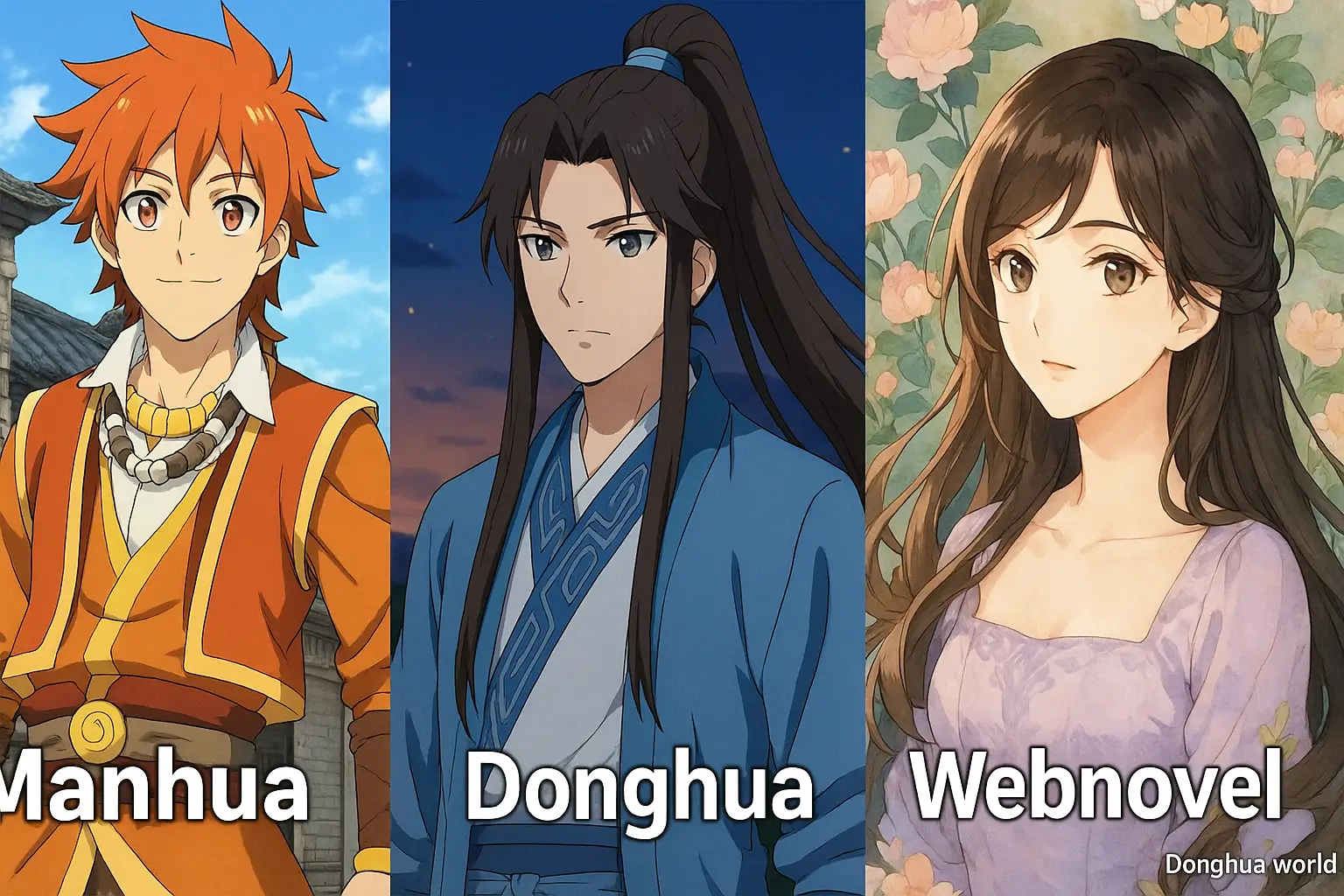In the world of Chinese pop culture, three major forms of media are gaining global attention: Manhua, Donghua, and Webnovels. Although they all share a connection with Chinese storytelling, each medium has its own distinct characteristics, audiences, and cultural significance. Understanding their differences helps fans appreciate the unique aspects of Chinese creative arts.
In this article, we’ll explore what makes each format special, compare them, and dive deep into their histories, notable examples, and influence around the world.
What is Manhua?
Manhua refers to Chinese comic books or graphic novels, originating from China, Hong Kong, and Taiwan. The term “Manhua” (漫画) literally translates to “whimsical drawings.”
Brief History of Manhua
Manhua can be traced back to ancient Chinese drawings and woodblock prints. However, the modern form of Manhua began to develop in the early 20th century, inspired by Western comics and Japanese manga.
During the 1920s and 1930s, political satire and humor were common themes. After 1949, under the influence of the Chinese government, Manhua became a tool for propaganda and education. Hong Kong, free from Mainland restrictions, became a hub for creative and diverse Manhua styles.
Quote:
“Manhua provides a mirror to Chinese society, much like comics in the West.” — Paul Gravett, comic historian and author of “Manga: Sixty Years of Japanese Comics”
Key Characteristics of Manhua
- Art Style: Vibrant, colorful, detailed, with a mix of traditional Chinese aesthetics and modern influences.
- Formats: Printed books, online platforms.
- Themes: Action, romance, fantasy, martial arts (Wuxia), slice of life.
- Reading Direction: Traditionally left-to-right, unlike Japanese manga (right-to-left).
Famous Manhua Titles
- The Ravages of Time (火凤燎原) by Chan Mou
- City of Darkness (黑夜之城) by Andy Seto
- Feng Shen Ji (封神纪) by Zheng Jian He
What is Donghua?
Donghua (动画) simply means “animation” in Chinese. In the global context, it refers specifically to Chinese animated TV series and movies.
Evolution of Donghua
Donghua’s history dates back to the 1920s, but the major boom happened post-2000s. Thanks to technological advancements and international platforms like Bilibili and Tencent Video, Donghua has exploded in popularity.
Early Donghua, such as Havoc in Heaven (1961), used traditional hand-drawn animation heavily influenced by Peking opera aesthetics. Modern Donghua utilizes CGI and hybrid techniques, producing stunning visual experiences.
Quote:
“The rise of Donghua is shaping the global animation landscape.” — Animation World Network (AWN)
Key Features of Donghua
- Art Style: Ranges from realistic to highly stylized fantasy.
- Genres: Cultivation (Xianxia), romance, adventure, science fiction.
- Language: Primarily Mandarin Chinese, but many series are dubbed in other languages.
- Audience: Youths, young adults, and increasingly, international viewers.
Popular Donghua Series
- The King’s Avatar (全职高手)
- Scissor Seven (伍六七之最强发型师)
- Heaven Official’s Blessing (天官赐福)
- Battle Through the Heavens (斗破苍穹)
What is a Webnovel?
Webnovels are serialized novels published online, mostly on platforms like Qidian (起点中文网), 17K, and WuxiaWorld.
Growth of Webnovels in China
Starting in the early 2000s, webnovels became a dominant force in Chinese literature. Due to the internet boom, aspiring authors gained the ability to reach wide audiences directly without traditional publishers.
Sites like Qidian provided authors with payment per chapter read, incentivizing frequent updates and reader interaction.
Quote:
“Chinese webnovels are revolutionizing literature in the digital age.” — BBC News, 2020
3.2 Traits of Chinese Webnovels
- Length: Often extremely long (millions of words).
- Genres: Cultivation (Xianxia), Urban Fantasy, Historical Romance, Gaming, Science Fiction.
- Writing Style: Fast-paced, cliffhangers, detailed world-building.
- Reader Interaction: Readers can comment, donate, and influence story directions.
Famous Webnovel Titles
- Martial World (武极天下) by Cocooned Cow
- The King’s Avatar (全职高手) by Butterfly Blue
- Release That Witch (放开那个女巫) by Er Mu
Key Differences at a Glance
| Aspect | Manhua | Donghua | Webnovel |
|---|---|---|---|
| Medium | Comic/Graphic Novel | Animated Series/Film | Online Serialized Novel |
| Format | Printed/Digital | Streaming | Online Text |
| Art Style | Static, detailed | Animated, colorful | Pure text, imaginative |
| Audience | Teens to adults | Wide range | Teens to adults |
| Famous For | Artwork | Animation Quality | Storytelling Depth |
How They Connect
Interestingly, many popular Donghua are adaptations of Webnovels or Manhua. For example:
- Battle Through the Heavens started as a Webnovel → adapted into Manhua → adapted into Donghua.
- The King’s Avatar was first a Webnovel → later adapted into Donghua.
This interconnectedness enriches the entire ecosystem, allowing fans to enjoy their favorite stories across multiple formats.
The Global Impact
Thanks to international streaming platforms (e.g., Netflix, Crunchyroll) and fan translation communities, Manhua, Donghua, and Webnovels are reaching a wider global audience than ever.
China Literature Limited, the parent company of Webnovel.com, reported in 2023 that international readership grew by over 30% year-on-year.
Global fandoms now engage in discussions, fan arts, and even cosplay inspired by these works.
Conclusion
While Manhua, Donghua, and Webnovels share a common cultural root, each offers a unique way to experience Chinese storytelling. Whether through colorful pages, animated adventures, or deep narratives, these mediums continue to captivate audiences worldwide.
As these industries evolve, one thing is certain: the world is paying more attention to Chinese creativity than ever before.
